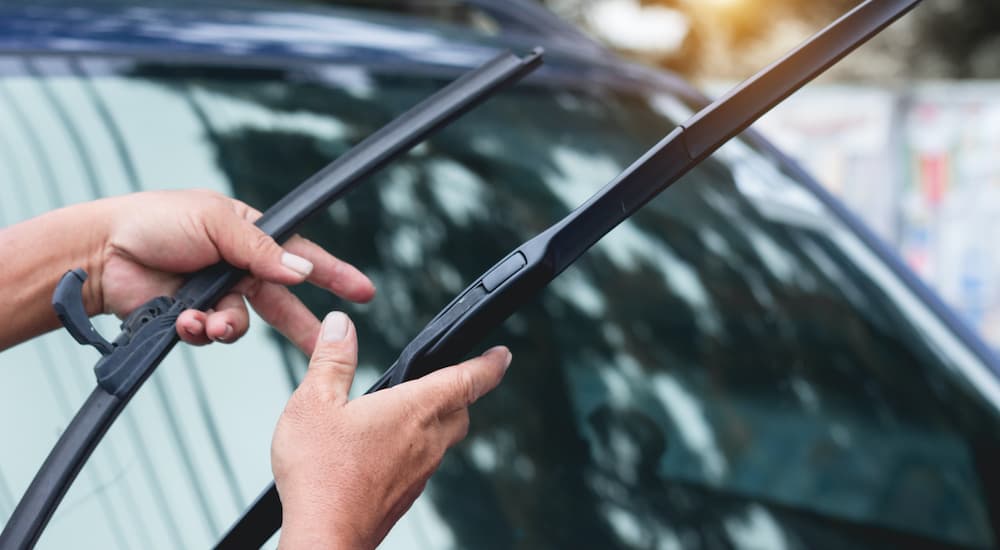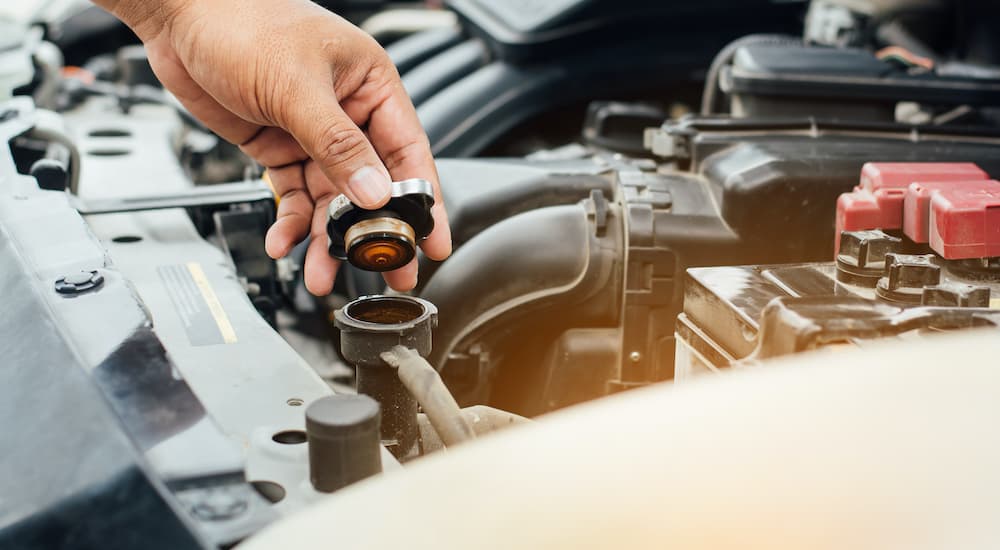The nimble 2021 Nissan Rogue Sport is popular for the essentially maintenance-free ownership experience it promises. Nissan has designed the Rogue Sport with long-lasting components and includes a robust warranty that covers everything for years. It’s a DIY car guy’s dream because it’s possible to perform all the basics at home in your own garage. All you need is your Rogue Sport’s owner’s manual, a few handy tools, and a list of parts that you’ll want to purchase from an authorized Nissan dealer (to assure authenticity) and keep on hand when the time comes to swap them out.
At-home maintenance should never entirely replace the scheduled kind you’re supposed to receive at regular intervals per factory recommendations. But there are plenty of small components, like filters, fluids, and wiper blades, that you can replace and maintain yourself, saving time and money in the process. If you’re not afraid to raise the hood and get your hands dirty, these items can be taken care of anytime you have a spare hour. What’s involved in simple at-home maintenance? Surprisingly, not much.
Maintaining Fluid Levels
Your Nissan Rogue runs on simple fluids that keep engine and transmission parts lubricated and running great. As fluids age, they gunk up with debris collected as they run through vehicle components. Eventually, viscosity – or thickness – increases to the point that the fluids could actually damage the car’s engine or other powertrain parts.
Your best defense is to regularly check a few different fluids to ensure they’re topped off, relatively clear, and consistent in viscosity as recommended by Nissan. The 2021 Rogue Sport comes with a comprehensive owner’s manual that’s also available electronically on Nissan’s website. Turn to Chapter 8: Do-it-yourself, and you’ll find everything you need to get started.
The manual includes a diagram that clearly indicates where you can find fluid reservoirs, including engine coolant, brake fluid, and window washer fluid. It’s simple to check and top these fluid levels off right at home once you familiarize yourself with their location. Don’t forget engine oil, which is probably the easiest after windshield washer fluid. For washer fluid, we recommend not waiting until the reservoir is empty, especially in the winter. Check it and refill it every month or so.
To check coolant, make sure the engine is cold. The Rogue Sport features an easy-to-read guide within the coolant reservoir, so check to see if the level has fallen below the MIN mark. If so, simply add coolant. Always ensure the reservoir’s cap is tightly sealed when you’re done, and note whether the coolant levels are frequently low. That may indicate a problem, which should be addressed by an authorized Nissan technician.
Some believe that checking the engine oil is as simple as pulling out the dipstick, but actually, you need to do some prep first. The vehicle should be parked on a level surface, and you should run the engine until it’s warmed up. Then, turn off the engine and wait for 5-10 minutes. After the time has elapsed, remove the dipstick and wipe it clean. Reinsert it and check the level. If oil levels are low, fill just to the H mark, being careful not to overfill.

Replacing Wiper Blades
Your windshield wipers perform an invaluable task: they are 100 percent responsible for providing visibility in inclement weather. If they’re worn from use or exposure to the elements, you don’t want to find that out the hard way. Nothing is worse than discovering your wipers aren’t up to the task in the middle of a downpour. Instead, periodically check them for wear and keep an extra set on hand so that you have them when you need them.
Is it hard to change your own wiper blades? No. It’s actually simple. It takes just a few minutes, and on the Rogue Sport it doesn’t even require any tools. Taking a minute to familiarize yourself with the steps will save time and money. You’ll feel good about handling it on your own instead of making a trip to the auto parts store and asking for help. Also, we often find that our wipers are worn right when we need them, so it isn’t always convenient to wait for a service appointment.
Simply lift the wiper arm up and away from the windshield. They pivot easily, so this process is pretty intuitive. Once they’re up, locate the release tab. Push and hold it, then slide the blade off the arm. Take your new wiper blade and reverse the process. You’ll hear a click when it’s securely in place. You’ll want to rotate the blade to situate the dimple in the groove. If you get stuck, just refer to the illustration in the owner’s manual.
Don’t forget the rear windshield wiper blade! This one works a little differently because there’s a water nozzle right on the blade mechanism. Because the rear wiper on the Rogue Sport is a little trickier and not as imperative as your front windshield wipers, it might be easier to ask your Nissan service technician to change it for you at your next scheduled maintenance visit.
One other note about windshield wiper blades: if your vehicle sits unused for long periods of time, it’s possible that even new wiper blades can become brittle. A good rule of thumb is to check your wiper blades for proper operability. You can do this by squirting a little washer fluid on the windshield and running them. If you see streaks, it is time to inspect the blades for debris and possibly replace them.

Other At-Home Routine Maintenance Tips
As a vehicle owner, it falls on you to ensure that your tires are properly inflated and have enough tread to carry you safely through bad weather. Whether you rely on your dealer or take on inspections yourself, it’s important to stay on top of your vehicle’s tire health. The good news is, basic tire maintenance is easy. Your Rogue Sport is equipped with a Tire Pressure Monitoring System (TPMS) that indicates when tire pressure is low via a light on the dash.
A word about TPMS: it’s not a failsafe. If, for example, you run over a nail or hit a pothole and suddenly lose tire pressure, the system isn’t sensitive enough to pick up on it quickly, and it only works at speeds above 16 mph. You should manually check tire pressure at least once a month, even if the TPMS system doesn’t indicate a problem. Simply purchase a digital tire pressure gauge or use an old-fashioned mechanical one and perform a quick check.
On the driver’s door, you’ll find a chart with recommended psi levels. You’ll want to check when the tires are cold, which means the vehicle should have been parked for at least three hours. Keep in mind that a small loss of tire pressure is normal with daily driving, which is why regularly checking your tires is important. Also, big temperature swings can accelerate tire pressure issues.
After tires, your vehicles’ exterior lighting is the second most important safety-related equipment for visibility and capable nighttime driving. Additionally, in most states, it’s illegal to operate a vehicle with burned-out exterior lights. To check your Nissan Rogue Sport, you’ll need to enlist the help of a friend. With one person standing in front of the vehicle, turn on the headlights and operate the high beams. Check both turn signals and ensure parking lights are working.
Repeat this process in the rear, checking brake lights, left and right turn signals, and parking lights. Don’t forget the third high-mounted brake light. All exterior lighting should be operable at all times, including your license plate light. Finally, put the car in reverse and check the backup lights. When checking your headlights and fog lights, inspect the lens covers for evidence of condensation or fogging. If you see any issues, bring your vehicle to a Nissan dealer for service.
It Isn’t Difficult to Maintain Your Rogue Sport!
Keeping your 2021 Nissan Rogue Sport in top mechanical condition is a team effort. You’re the captain, and you get to decide how and when you inspect and maintain your vehicle. As always, we highly recommend closely following the factory’s recommended maintenance schedule. Between visits, you can easily follow the guidelines above to keep your vehicle running optimally.

